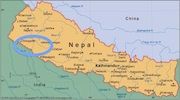The Primary School in Lakkad was completed on April 7, 2013!


The New School
Lakkad Community Profile
Lakkad is part of the Joshipur VDC (Village Development Committee) in the Kailali District of far western Nepal. This community was founded in 1811. Today there are approximately 1,600 people living in Lakkad. These villagers all practice various Hindu traditions, and 100% belong to the Kathariya ethnic group.
Lakkad is 89 km from the buildOn office in Dhangadhi and 29 km from the closest paved road. The leaders of the community are Mr. Sulind Kathariya and Mr. Min Raj Kathariya. There is a private medical clinic in Joshipur Bazaar 3 km from this village and a government health post in Joshipur VDC 4 km away.
Agriculture is the primary income generating activity in Lakkad. Families grow rice, wheat, oilseed, and vegetables. The climate is warm for most of the year, with cooler temperatures from November to January and the heaviest rains from June to August.
Lakkad is 89 km from the buildOn office in Dhangadhi and 29 km from the closest paved road. The leaders of the community are Mr. Sulind Kathariya and Mr. Min Raj Kathariya. There is a private medical clinic in Joshipur Bazaar 3 km from this village and a government health post in Joshipur VDC 4 km away.
Agriculture is the primary income generating activity in Lakkad. Families grow rice, wheat, oilseed, and vegetables. The climate is warm for most of the year, with cooler temperatures from November to January and the heaviest rains from June to August.

The Existing School Situation

The Old School
Chote Lal Smriti Primary School: There are currently 164 students enrolled in Chote Lal Smriti Primary School- 87 girls and 77 boys. They study with 4 teachers from the community in grades 1-4. This school was formally established just 4 years ago. There were no permanent classrooms in Lakkad prior to this project, so the students studied in a mud and wood structure with a thatch roof. These temporary classrooms are not adequate during the annual monsoon season. Because of the limited number of classrooms and teachers, some students also walked about 2 km to another community to continue their education after finishing primary school. Lakkad was chosen as a 2012 Opportunity for All/buildOn project site after word spread from a nearby 2011 project site about the success of the program.
The New School Project
The Lakkad school project broke ground on December 23rd 2012 and was completed on April 7th 2013. The people of Lakkad contributed a total of 1,396 volunteer workdays to the project, which finished 6 days behind schedule due to a strike in the area. Before beginning construction community members also collected local materials for the project and met with buildOn staff to sign a covenant outlining the following responsibilities:
Community Contribution
• Unskilled labor: 20 workers (10 women and 10 men) per day, six days per week
• Commitment to educating girls and boys equally
• The land on which the school will be built
• High quality local materials: sand, gravel, water & rocks
• Volunteer management committee made up of 12 villagers (six women, six men)
• Lodging for buildOn Field Coordinator and skilled laborers in local homes
• Basic construction tools (picks, buckets, etc.) when available
Opportunity For All / buildOn Contribution
• Engineering and architecture
• Construction materials (excluding local materials) for school and latrine
• Skilled labor and plans needed to build the school
• Project management (buildOn coordinators)
• Instruction in basic construction techniques
• School furniture
Community Contribution
• Unskilled labor: 20 workers (10 women and 10 men) per day, six days per week
• Commitment to educating girls and boys equally
• The land on which the school will be built
• High quality local materials: sand, gravel, water & rocks
• Volunteer management committee made up of 12 villagers (six women, six men)
• Lodging for buildOn Field Coordinator and skilled laborers in local homes
• Basic construction tools (picks, buckets, etc.) when available
Opportunity For All / buildOn Contribution
• Engineering and architecture
• Construction materials (excluding local materials) for school and latrine
• Skilled labor and plans needed to build the school
• Project management (buildOn coordinators)
• Instruction in basic construction techniques
• School furniture
